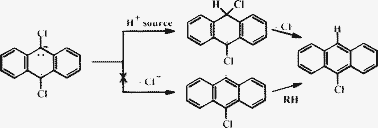2,5-Dimethyl-2,4-hexadiene induced photodechlorination of 9,10-dichloroanthracene
Abstract
Photochemical formation of

* Corresponding authors
a
Department of Chemistry and Biochemistry, The Florida State University, Tallahassee, Florida, USA
E-mail:
saltiel@chem.fsu.edu
Fax: +1 850-644-8281
Tel: +1 850-644-5405
b Laboratoire de Chimie Physique A, Université de Bordeaux I, Talence Cedex, France
Photochemical formation of

 Please wait while we load your content...
Something went wrong. Try again?
Please wait while we load your content...
Something went wrong. Try again?
J. Saltiel, W. K. Smothers, K. S. Schanze, S. A. Charman and R. Bonneau, Photochem. Photobiol. Sci., 2009, 8, 856 DOI: 10.1039/B821683E
To request permission to reproduce material from this article, please go to the Copyright Clearance Center request page.
If you are an author contributing to an RSC publication, you do not need to request permission provided correct acknowledgement is given.
If you are the author of this article, you do not need to request permission to reproduce figures and diagrams provided correct acknowledgement is given. If you want to reproduce the whole article in a third-party publication (excluding your thesis/dissertation for which permission is not required) please go to the Copyright Clearance Center request page.
Read more about how to correctly acknowledge RSC content.
 Fetching data from CrossRef.
Fetching data from CrossRef.
This may take some time to load.
Loading related content
